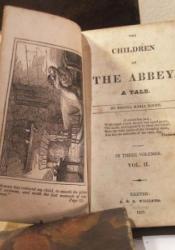Regina Maria Roche: The Children of the Abbey
Regina Maria Roche (1764-1845) is the author of a multitude of novels under the umbrella of Gothic literature, and is arguably most famous for The Children of the Abbey (1796). Roche’s writing style and content were so similar to that of Ann Radcliff’s, that she was known as “Ireland’s Anne Radcliff'' (Power). As contemporaries, both women drew heavily off the ground work that Barford Abbey (1768) set in the Gothic genre. With The Children of the Abbey being published more than 25 years after Barford Abbey, it contains what we now would expect from a sentimental Gothic novel from the 18th century: “gothic places, old mansions, a haunted abbey, [and] a twisted plot” (Harral). Even though some might believe that Roche’s career was overshadowed by that of Radcliff’s, it’s undeniable that Roche found great success in this particular book: “[the novel] is Radcliffian Gothic domesticated, entertaining readers with the charms of sentimental indulgence and escapist fantasy plut the occasional frisson of terror, all set reassuringly in the familiar context of late eighteenth-century polite society” (Howells). The Children of the Abbey seemed to have contained all the right ingredients for a commercially successful book in that time era. It possessed all of the trademark items of a good Gothic novel, adopted the traditional characteristics of a sentimental novel, and included a bit of fantastical imagination in a setting that would be comfortable and familiar to the intended audience.
Harral, Ashhesz, and Ashley Harral. “Regina Maria Roche – ‘The Children of the Abbey.’” Go to the Cover Page of From Cradle to Grave, Backwater to Empire, Dr. Erin Webster Garrett, 8 May 2013, c18digiemp.pressbooks.com/chapter/regina-maria-roche-the-children-of-the-abbey/#return-footnote-65-3.
Howells, Coral Ann. Love, Mystery, and Misery: Feeling in Gothic Fiction. London: The Athlone Press University of London, 1978. 82-100. Print.
Power, Albert. “Regina Maria Roche (1764-1845).” The Green Book: Writings on Irish Gothic, Supernatural and Fantastic Literature, no. 11, 2018, pp. 35–41. JSTOR, www.jstor.org/stable/48536178. Accessed 4 Apr. 2021.

